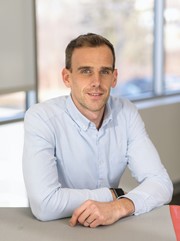
Q) Can you please introduce yourself in case some of our readers missed your latest webinar?
A) I’m Sam Ireland and I’m the Director of Marketing for EMEA and APAC with Loftware, the world’s largest cloud-based Enterprise Labeling and Artwork Management provider. My role at Loftware involves highlighting the value of our solutions, developing awareness of our brand, and growing our global footprint.
Q) How did you get started in the industry?
A) I was initially attracted to the industry because I saw opportunities to help businesses solve the many different challenges that interconnect with labeling, from ensuring compliance to driving business efficiencies to adapting to an ever-changing business landscape.
I joined Loftware because there is a clear value proposition to our solutions. I’d say that a career at Loftware is more than just a job – it’s an opportunity to help shape the supply chain of the future. And while a great deal of attention has been given to streamlining global supply chains, one of the most critical components is also the most overlooked: the label. At Loftware, we believe that labels are the connective tissue between all the different steps of the supply chain, therefore play a vital role in keeping parts and products moving – both upstream and downstream – without delays.
However, many organizations are still leaving labeling to chance as they rely on disparate solutions to meet evolving and growing business demands. Unfortunately, this approach can result in labeling errors, inconsistencies, high maintenance costs, and non-compliance. I want to help these businesses drive their labeling into the future.
Q) What do you enjoy most about your role?
A) Loftware really does make a difference every day to businesses of all sizes worldwide. I enjoy working across industries, from retail to manufacturing to food and beverage to life sciences and more. Our solutions are always evolving – backed by really smart teams who truly understand the needs of our customers and partners – so it’s clear that the value case really stacks up.
Q) What is a problem in your industry that people don’t suspect and can learn to resolve from your recent webinar?
A) Driven by the COVID-19 pandemic, cloud technology has become increasingly attractive to manufacturers, distributers, and suppliers. Its quick deployment times, low upfront costs, easy access, ability to scale, and seamless updates benefited companies when operations were disrupted by shifts in supply chain models. As such, many companies are currently running digital transformation programs that include moving core business applications to the cloud. However, it’s vital that labeling be considered as part of that process. By deploying labeling in the cloud, businesses will see several benefits, including cost savings, accessibility from any location at any time, next-level security, efficiency gains, and more.
Q) Why did you choose this topic for your recent webinar?
A) As noted in our recent report, ‘Top 5 Trends in Labeling and Packaging Artwork’, 42% of business leaders have already embraced a cloud-first strategy for enterprise applications and a further 73% of $1bn+ companies believe the cloud will be the preferred method for labeling applications in the next three years. When speaking to our customers and partners, it’s clear that one subject is top of mind: cloud adoption. Forward-thinking companies see the opportunity. There is huge potential to scale, standardize practice, and ultimately drive improvements across the enterprise. Businesses that can effectively pivot and embrace new plans for maintaining business will have a competitive edge and set themselves up for future success.
Q) Do you have any advice for younger & upcoming professionals who are just getting started on their career journey from your latest webinar?
A) In terms of labeling, it is a great field for growth and continuous learning. Most importantly, it’s the backbone of many industries, which means that you can make a significant impact across your entire company. Advocate for the value your business can take from improving its labeling processes and help to make the case for improvements.
From a marketing perspective, choose a company that delivers on its value and enjoy making the success stories that will resonate with your target audience.
Q) What would someone be surprised to know about you?
A) Ah! One of those questions that makes me realize I’m not full of surprises! I used to be a drummer and really miss it. I wish I had continued to play over the past years, though my family probably think differently!
Click here to register and watch Loftware’s recent webinar 7 business-boosting benefits of cloud labeling on-demand from Wednesday 4th May 2022, 3PM BST.









